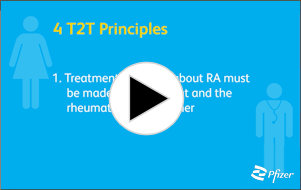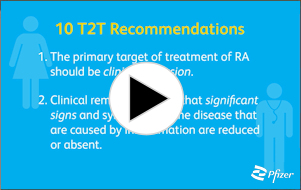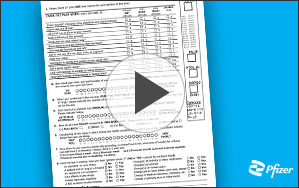
The following materials―created by Pfizer Medical Affairs―provide important content for adult patients who have RA. These materials:
- Offer insights for adult patients into the characteristics of RA and how it can be managed
- Provide a refresher for adult patients on disease-related information that can be used to educate family members or friends about RA
- Can help patients track their RA disease activity and functional status
- Can help support the Treat-to-Target (T2T) approach to care based on shared decision-making and routine assessment of RA disease activity
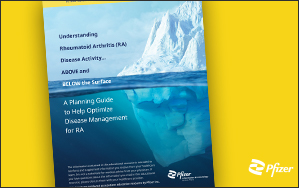
Read an overview of RA and the importance of taking your medicine as prescribed.

This in-depth instructional video provides detailed information on RA including common signs and symptoms, the underlying causes of RA, and disease management approaches
CLOSE
Understanding T2T
Treat-to-Target (T2T) emphasizes the process of shared decision-making between patients and members of the medical team. Shared decision-making can only happen if patients are well informed about RA and their treatment options and communicate their expectations. The educational information on this site may help patients be better prepared to discuss their treatment choices, goals, and objectives with their HCPs.
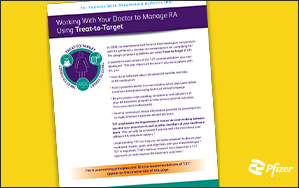
Read about the 4 T2T Principles and the 10 T2T Recommendations, which outline the goals of an RA treatment plan and the ways HCPs measure RA disease activity.
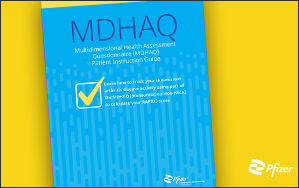
This guide helps patients understand how to use the MDHAQ (Multi-Dimensional Health Assessment Questionnaire) to calculate their RAPID3 (Routine Assessment of Patient Index Data 3) score by answering 3 lifestyle-related questions. The guide also instructs patients on how to work with their doctor to apply this score to track their RA disease activity over time.
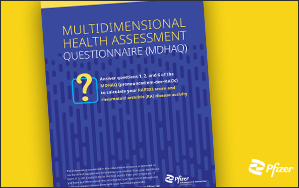
This 2-page questionnaire allows patients to calculate their MDHAQ score and their RAPID3 score, which may be used to assess their level of RA disease activity. Patients can write down their scores and bring the information to their next doctor's appointment.
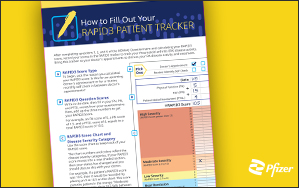
This resource lets you record your RAPID3 scores—based on questions in the MDHAQ questionnaire—in order to monitor your RA disease activity and identify important information for discussion with your healthcare professional.
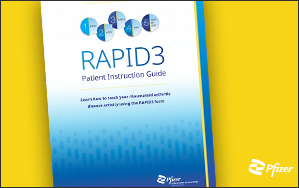
This guide helps patients learn how to use the RAPID3 (Routine Assessment of Patient Index Data 3) form to calculate a RAPID3 score. The RAPID3 survey converts patients' answers on how RA is affecting them into a numerical score that can be used to monitor RA disease activity over time.
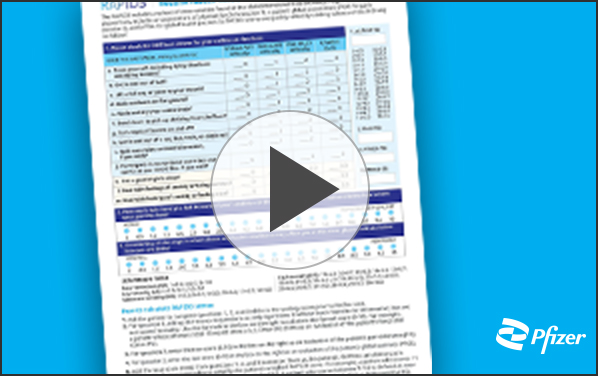
Explore the RAPID3 self-assessment questionnaire and how to use it to calculate the RAPID3 score. This video provides step-by-step instructions on how to complete the RAPID3 Questionnaire, as well as how to record information for discussion with healthcare professionals.
Play Video (English version)
RAPID3 Simple Form (ENGLISH)
CLOSE
Play Video (Spanish version)
RAPID3 Simple Form (ESPAÑOL)
CLOSE
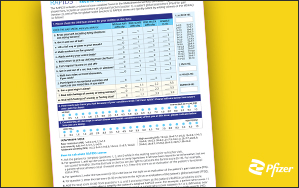
This self-assessment questionnaire generates information to help calculate a RAPID3 score and provides an explanation of those numerical results. Patients can write down their scores and bring the information to their next doctor's appointment.
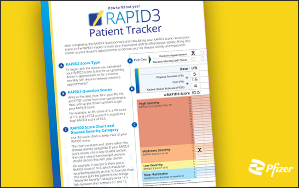
This logbook enables you to record your RAPID3 scores, based on the RAPID3 questionnaire, to monitor your RA disease activity and identify important information for discussion with your healthcare professional.
aReproduction or distribution of this material is strictly prohibited without permission.
The RAPID3 system, and all copyright and trademark rights related thereto, is owned by Theodore Pincus and incorporated herein under license.

